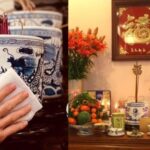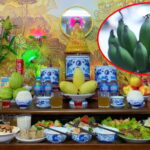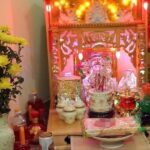Each flower is unique in its beauty and holds a special symbolic meaning. Depending on your intentions, needs, or feng shui beliefs, you can select the perfect flowers to display and create a meaningful atmosphere.
1 The Significance of Offering Flowers at the Ancestral Altar During Tet
Offering flowers at the ancestral altar during Tet is a significant spiritual practice for Vietnamese people, especially during festivals, holidays, and other special occasions. This act of devotion holds a profound significance in the cultural tradition of ancestor worship.
Presenting flowers at the altar demonstrates the deep reverence and gratitude of the family towards their beloved ancestors and deities. It is a way to honor and connect with their spiritual heritage.
Flowers are chosen as offerings because they embody beauty, goodness, and purity—qualities that are highly valued in Vietnamese culture and spiritual practices.
2 Flowers Suitable for the Ancestral Altar During Tet
When selecting flowers for the ancestral altar during Tet, it is important to choose those with pleasant-sounding names, a gentle fragrance, and a long vase life as a sign of respect to the elders and ancestors. Here are some of the most common and suitable flowers for this occasion:
Lotus Flower
 The elegant and pure lotus flower
The elegant and pure lotus flower
The lotus flower is a symbol of purity and beauty. Growing in muddy waters without being tainted, it represents resilience and the ability to rise above challenges. Additionally, the lotus holds a special place in Buddhism and is often associated with enlightenment.
With its graceful beauty and subtle fragrance, the lotus flower is an ideal choice for the ancestral altar. It is believed to bring good fortune, prosperity, and blessings for the entire year to the family.
Peach and Apricot Blossoms
 Traditional and vibrant peach and apricot blossoms
Traditional and vibrant peach and apricot blossoms
Peach and apricot blossoms are traditional choices for the Tet holidays. These vibrant flowers symbolize abundance, peace, and happiness. They are believed to ward off bad luck and evil spirits, bringing positive energy to the ancestral altar.
While peach blossoms are associated with prosperity, the apricot blossom represents wealth, honor, and good luck. Together, they create a harmonious and auspicious display.
Money Plant
 Vibrant money plants for a prosperous new year
Vibrant money plants for a prosperous new year
The money plant is offered with the hope of bringing good fortune and wealth to the family in the coming year. Its vibrant colors and beautifully blooming petals make it an ideal choice for ancestral offerings. The money plant also symbolizes robust health and vitality, wishing the family a year full of energy and positivity.
Red Roses
 Majestic red roses add elegance
Majestic red roses add elegance
Red roses are known for their majestic and exquisite beauty. They are commonly used for the ancestral altar during festivals, Tet, and death anniversaries. The red color of the roses symbolizes good luck, financial prosperity, abundance, peace, and happiness for the family. Their elegant presence enhances the sacredness of the occasion.
White Lilies
 White lilies for solemn occasions
White lilies for solemn occasions
White lilies are chosen for their purity and elegance. They are typically offered during solemn occasions, symbolizing the family’s wish for abundance, wealth, and prosperity. While white lilies are the most common choice, lilies also come in various vibrant colors, all of which are suitable for offering at the ancestral altar.
Yellow Chrysanthemums
 Long-lasting yellow chrysanthemums for good fortune
Long-lasting yellow chrysanthemums for good fortune
Yellow chrysanthemums are known for their strong vitality and long vase life, making them an excellent choice for the ancestral altar. The image of their petals gracefully falling on the altar signifies good luck and wealth for the family in the coming year. Their bright and cheerful presence adds a touch of warmth to the occasion.
3 Flowers to Avoid on the Ancestral Altar During Tet
Lilies
 Lilies are avoided during the new year
Lilies are avoided during the new year
During the first days of the new year, flowers with thorny or inauspicious names, such as lilies, are believed to bring about family separation. Therefore, it is considered unlucky to display them in the house during this time.
Jasmine and Gardenia
Despite their pleasant fragrance and pure appearance, jasmine and gardenia are not displayed on the ancestral altar. These flowers are often associated with folk tales of inappropriate relationships between men and women, which is considered inauspicious for this sacred occasion.
Moreover, there is a belief that these flowers are haunted by spirits, and bringing them into the house during Tet is not advisable.
 Flowers to avoid during Tet
Flowers to avoid during Tet
Hibiscus
Although hibiscus flowers are beautiful, they are not chosen for the ancestral altar due to their unique characteristics. Hibiscus flowers “bloom in the morning and wither at night”, and they also tend to change color throughout the day. This instability is not considered auspicious for the occasion.
Marigolds
Marigolds are not placed on the ancestral altar because of their strong and unpleasant fragrance. They fail to convey the solemnity and purity typically associated with this sacred tradition.
Orchids
While orchids can be used to decorate the house, they are not displayed on the ancestral altar during Tet. Some believe that the word “orchid” implies promiscuity and waywardness, making it unsuitable for this respectful occasion.
4 How to Display Flowers on the Ancestral Altar During Tet
When arranging flowers on the ancestral altar during Tet, it is important to create a balanced and harmonious composition. The flowers should stand straight and not spread to the sides, as a sign of utmost respect.
On the altar, it is recommended to place a maximum of two vases of flowers, with a sparse yet elegant arrangement. Two or three different types of flowers can be chosen to create a diverse yet cohesive display. However, avoid using too many varieties to prevent a cluttered and overwhelming look.
The flowers offered are a representation of the family’s sincerity. When making an offering, it is essential to come from a place of genuine heartfelt intention and to lead a life filled with good deeds and positivity. This will invite prosperity and blessings into the home.
 Tips for a respectful and elegant display
Tips for a respectful and elegant display
We hope that this guide will help you create a meaningful and respectful flower display for your ancestral altar during Tet. Best wishes for a prosperous and joyful new year!



































